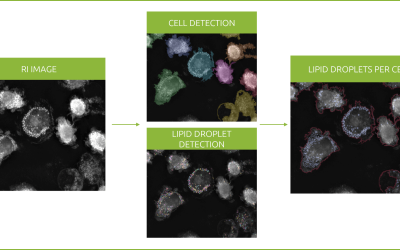Welcome to the first edition of the AI for Live Cell Insights newsletter, bringing you the latest live cell analyses powering drug discovery and cosmetics development. Each month, we will explore a new application of AI-based cellular analysis for label-free live cell imaging, with publication highlights and news from Nanolive. This month, we are kicking off with live cell analysis for cytotoxic drug profiling.
Live cell imaging for drug candidate profiling
Phenotypic data from live cell imaging can be used to measure changes at the cellular and organelle levels, and can indicate responses such as cellular stress before cell death is detectable. Monitoring phenotypic changes over time in label-free images is therefore a sensitive and non-invasive method for detecting drug effects and mechanism of action.
To characterize and assess multiple drug candidates, the group of José Padrón at Universidad de La Laguna used Nanolive SA holotomographic imaging, combined with automated analysis and machine learning software in their recent publication ‘Early pharmacological profiling of isatin derivatives as potent and selective cytotoxic agents’. Live imaging was identified as a key tool for quantifying and characterizing drug-induced phenotypic changes in cells;
“Continuous live cell imaging allows to analyze the potency of the compounds and their predominant mode of death, in addition to the kinetics of cell death.”
Cellular dry mass, form factor, area and compactness were quantified automatically during the 15h imaging period using EVE Analytics (Nanolive), and the mechanism of cell death was identified as necrosis by Nanolive’s LIVE Cell Death Assay (now the LIVE Cytotoxicity Assay) which uses machine learning to differentiate between living, apoptotic, and necrotic cells.
To read the full paper Early pharmacological profiling of isatin derivatives as potent and selective cytotoxic agents, Puerta et al. (2024) click here.
Author testimonial
The Padron lab has been pioneering use of Nanolive’s AI technology since 2021, and provided the following testimonial for the LIVE Cell Death Assay (now the LIVE Cytotoxicity Assay):

Holotomography and automated analysis
Nanolive’s label-free holotomographic technology makes it possible to image cells for long periods of time, at high resolution. The quantity and complexity of the images generated allows visualization of biological processes in unprecedented detail from the population to subcellular level. EVE Analytics forms the backbone of Nanolive’s digital assays for phenotypic analysis, providing a simple tool to segment and measure every cell automatically.
To read the eBook for more details about holotomography, click here.

Monitoring cell health and stress in timelapse images
The LIVE Cytotoxicity Assay (previously the LIVE Cell Death Assay) can be used for label-free monitoring of phenotypic responses of cells, using morphological markers such as cell area, or Nanolive’s unique metric, the Health Cell Index. As well as cell death monitoring, this digital assay enables the detection of cell stress and stress-induced morphological changes to aid detection of drug candidates with harmful effects that cannot be detected by standard cytotoxicity assays.
To learn how cell stress can be monitored using phenotypic data, and how anastasis (reversible apoptosis) can be detected, check out the case studies in our application note here.

Change in pre-adipocyte morphology during heatshock and imaging timelapse. Cells are digitally colored green (living) to brown (dead) by the LIVE Cytotoxicity Assay.
Latest publication highlights with Nanolive imaging:
- Nanomaterials: Depciuch, J. et al. (2024) ‘Modeling Absorption Dynamics of Differently Shaped Gold Glioblastoma and Colon Cells Based on Refractive Index Distribution in Holotomographic Imaging’, Small, https://doi.org/10.1002/smll.202400778
- Immunooncology: Wang, W. et al. (2024) ‘Biological impact and therapeutic potential of a novel camptothecin derivative (FLQY2) in pancreatic cancer through inactivation of the PDK1/AKT/mTOR pathway’, Bioorganic Chemistry, https://doi.org/10.1016/j.bioorg.2024.107436
- Parasitology: Ross, R. et al. (2024) ‘Human dendritic cell interactions with the zoonotic parasite Cryptosporidium parvum result in activation and maturation’, Frontiers in Immunology, https://doi.org/10.3389/fimmu.2024.1388366
- Cellular metabolism: Lamela, F. et al. (2024) ‘Differential effects of coverslip-induced hypoxia and cobalt chloride mimetic hypoxia on cellular stress, metabolism, and nuclear structure’, Tissue & Cell, https://doi.org/10.1016/j.tice.2024.102408
- Immunology: Yu, F. et al. (2024) Loss of the TRPM4 channel in humans causes immune dysregulation with defective monocyte migration, Journal of Allergy and Clinical Immunology, https://doi.org/10.1016/j.jaci.2024.02.026
- CAR-T engineering: Valentić, B. et al. (2024), The Glucose Transporter 5 Enhances CAR-T Cell Metabolic Function and Anti-tumour Durability, Research Square, https://doi.org/10.21203/rs.3.rs-4342820/v1
Find over 250 publications featuring Nanolive imaging here.
Subscribe to this monthly newsletter to stay up to date with AI applications in cell biology.
Read our latest news
Newsletter June 2024: AI-powered Microscopy Reveals SARS-CoV-2 Impact on Organelle Dynamics
Welcome to the June edition of the AI for Live Cell Insights Newsletter, bringing you the latest live cell analyses powering drug discovery and cosmetics development. Each month, we will explore a new application of AI-based cellular analysis for label-free live cell...
Online Demo: Transforming drug discovery with AI-powered live cell analysis
Reveal cellular stories with AI Join us for an exclusive demonstration tailored for biopharma professionals and academic researchers, showcasing Nanolive’s cutting-edge live cell imaging and analysis technology. Discover our unique holotomographic microscope and...
Revolutionizing lipid droplet analysis: insights from Nanolive’s Smart Lipid Droplet Assay Application Note
Introducing the Smart Lipid Droplet Assay: A breakthrough in label-free lipid droplet analysis Discover the power of Nanolive's Smart Lipid Droplet Assay (SLDA), the first smart digital assay to provide a push-button solution for analyzing lipid droplet dynamics,...



